start CITROEN C1 2020 User Guide
[x] Cancel search | Manufacturer: CITROEN, Model Year: 2020, Model line: C1, Model: CITROEN C1 2020Pages: 269, PDF Size: 7.63 MB
Page 30 of 269

28
With the touch screen tablet
From the Menu page in the touch screen tablet:
F Sel ect the " Vehicle information "
tab.
The " Trip information "
window is displayed
w
ith the following information:
-
"A
verage speed ",
-
" E
lapsed time ",
-
" R
ange",
-
t
he current fuel consumption, presented in
g
raphical
fo
rm.
The " Erase "
button resets the fuel consumption
d
ata in the touch screen tablet and the
in
strument
pan
el.
If your vehicle has a touch screen tablet, you
can
view information on the current journey.
Trip computer, a few definitions
Range
(miles or km)
T he distance which can still be travelled with
t
he fuel remaining in the tank (related to the
a
verage fuel consumption over the last few
m
iles
(
kilometres)
t
ravelled).
This
value may vary following a change
i
n the style of driving or the relief,
r
esulting in a significant change in the
c
urrent fuel consumption.
When
the fuel level is low, the message
"
Lo FUEL" is displayed.
If
only a small amount of fuel is added, the
r
ange may not be recalculated.
Current fuel consumption
(mpg or l/100 km or km/l)
C alculated over the last few seconds.
Stop & Start time counter
(minutes / seconds or hours / minutes)
I f your vehicle is fitted with Stop & Start, a time
c
ounter calculates the time spent in STOP
m
ode during a journey.
It
resets to zero every time the ignition is
s
witched on.
Average fuel consumption
(mpg or l/100 km or km/l)
C alculated since the last trip computer reset.
Average speed
(mph or km/h)
C alculated since the last trip computer reset.
Instruments
Page 36 of 269
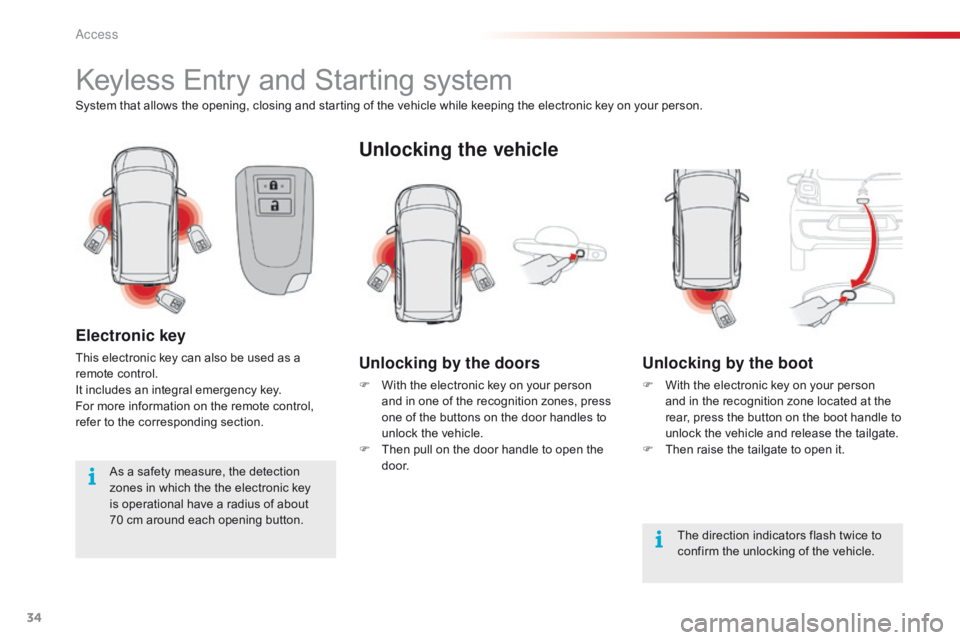
34
C1_en_Chap02_ouvertures_ed01-2016
Keyless Entry and Starting system
System that allows the opening, closing and starting of the vehicle while keeping the electronic key on your person.
Electronic key
This electronic key can also be used as a remote control.
It
includes an integral emergency key.
For
more information on the remote control,
r
efer to the corresponding section.
Unlocking the vehicle
Unlocking by the doors
F With the electronic key on your person a
nd in one of the recognition zones, press
o
ne of the buttons on the door handles to
u
nlock the vehicle.
F
T
hen pull on the door handle to open the
d
o o r.
Unlocking by the boot
F With the electronic key on your person a
nd in the recognition zone located at the
r
ear, press the button on the boot handle to
u
nlock the vehicle and release the tailgate.
F
T
hen raise the tailgate to open it.
The
direction indicators flash twice to
c
onfirm the unlocking of the vehicle.
As
a
safety
measure,
the
detection
z
ones
in
which
the
the
electronic
key
i
s
operational
have
a
radius
of
about
7
0 cm
around
each
opening
button.
Access
Page 37 of 269
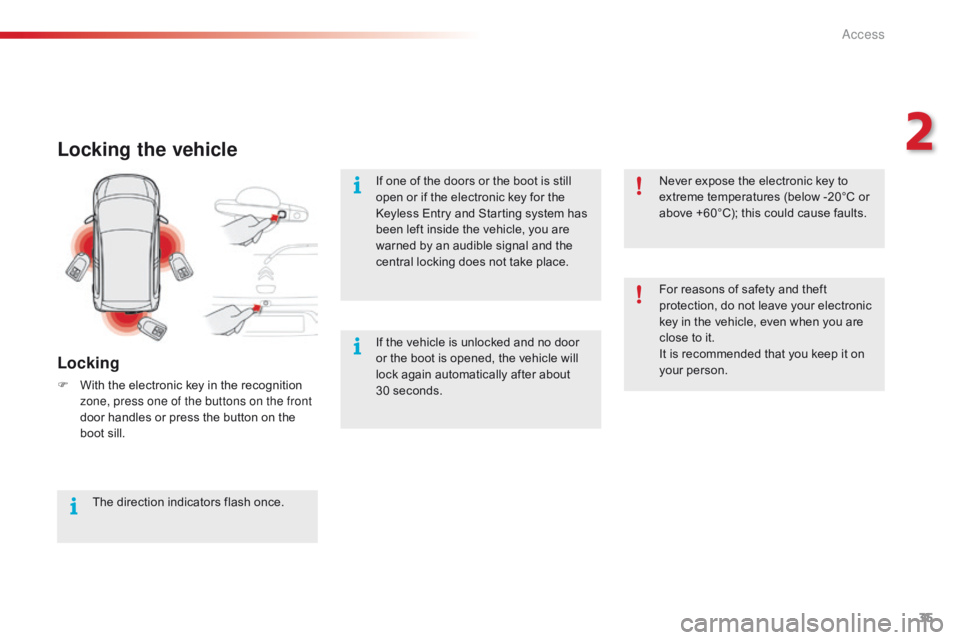
35
C1_en_Chap02_ouvertures_ed01-2016
Locking the vehicle
Locking
F With the electronic key in the recognition z
one, press one of the buttons on the front
door
handles or press the button on the
b
oot sill.
The
direction indicators flash once.If
one of the doors or the boot is still
o
pen or if the electronic key for the
K
eyless Entry and Starting system has
b
een left inside the vehicle, you are
w
arned by an audible signal and the
c
entral locking does not take place.
If the vehicle is unlocked and no door
o
r the boot is opened, the vehicle will l
ock again automatically after about 3
0 seconds.For
reasons of safety and theft
p
rotection, do not leave your electronic
k
ey in the vehicle, even when you are
c
lose to it.
It is recommended that you keep it on y
our person.
Never expose the electronic key to
e
xtreme temperatures (below -20°C or
a
bove +60°C); this could cause faults.
2
Access
Page 38 of 269

36
C1_en_Chap02_ouvertures_ed01-2016
Emergency procedure
Unlocking
F Insert the integral key into the driver's door l
ock barrel and turn it towards the front of
t
he vehicle to unlock the vehicle.
Locking
F Insert the integral key into the driver's door l
ock barrel and turn it towards the rear of
t
he vehicle to lock the vehicle.
The
integral
key
is
used
to
lock
and
unlock
the
v
ehicle
when
the
electronic
key
cannot
operate
a
nd
in
the
event
of
a
fault
with
the
Keyless
E
ntry
and
Starting
system:
-
c
ell
battery
discharged,
vehicle
battery
d
ischarged
or
disconnected,
...
-
v
ehicle
located
in
an
area
with
strong
e
lectromagnetic si
gnals.
F
P
ress
and
hold
the
latch
1
to
extract
the
i
ntegral
key
2 .
Saving the electronic key
battery
To preserve the battery, it is possible to prevent
the
electronic key working (no reception of
r
adio waves).
When
this function is activated, the "Keyless
E
ntry and Starting" system is inoperative.
To
reactivate the electronic key, press one of
t
he buttons (open or closed padlock).
F
P
ress on the open padlock twice,
w
hile pressing on and holding
t
he closed padlock.
Check
that the indicator lamp in the electronic
k
ey flashes 4 times.
Access
Page 39 of 269

37
C1_en_Chap02_ouvertures_ed01-2016
Changing the battery of
the electronic key
Battery ref.: CR2032 / 3 volts.
W hen replacement of the battery is
n
eeded, this warning lamp comes on
i
n the instrument panel.
F
U
nclip the cover using a small screwdriver
a
t the cutout.
F
R
emove the cover.
F
R
emove the protective battery holder,
p
ulling it upwards.
F
R
emove the discharged battery from its
h
ousing.
F
F
it the new battery into its housing
o
bserving the original direction of fitment.
F
R
efit the battery holder.
F
C
lip the cover onto the casing.
Lost keys
Go to a CITROËN dealer with the vehicle's registration document, your personal identification documents and if possible the key code label.
The
CITROËN dealer will be able to look up the key code and the transponder code
r
equired to order a new key.
Remote control / Electronic key
These high frequency devices are sensitive systems; do not handle them while in your pocket as there is a risk of unlocking the vehicle, without you being aware of it.
Do
not repeatedly press the buttons of your remote control or electronic key out of range
a
nd out of sight of your vehicle. You run the risk of stopping it from working and the remote
c
ontrol would have to be reinitialised.
Locking the vehicle
As a safety precaution, never leave children alone in the vehicle, except for a very short period.
In
all cases, it is essential to remove the key from the ignition switch, or take the electronic
k
ey with you when leaving the vehicle.
When purchasing a second-hand vehicle
Have the pairing of all of the keys in your possession checked by a CITROËN dealer, to ensure that only your keys can be used to open and start the vehicle.
Driving
with the doors locked may make access to the passenger compartment by the
e
mergency services more difficult in an emergency.
2
Access
Page 42 of 269
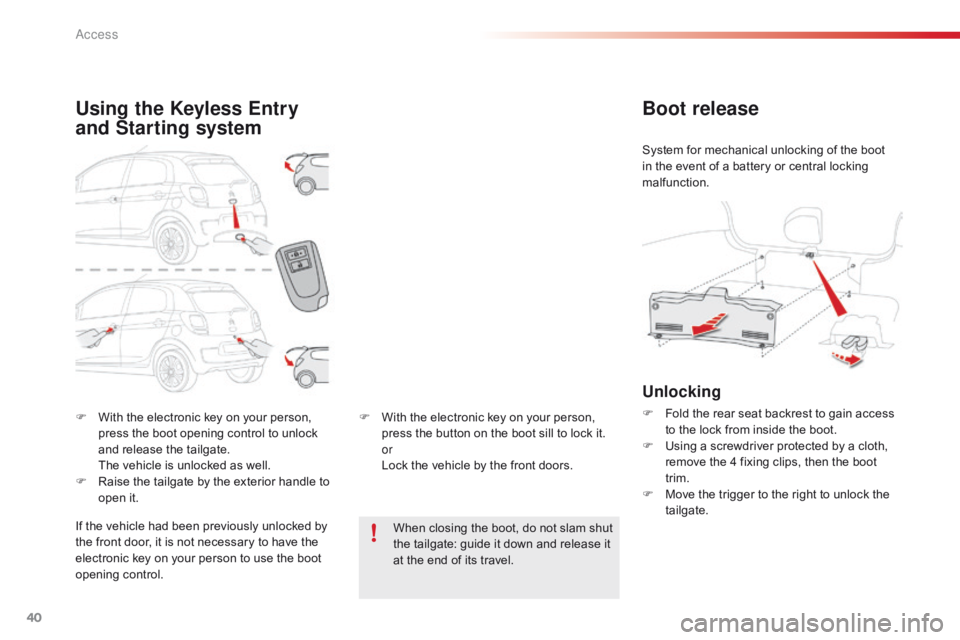
40
C1_en_Chap02_ouvertures_ed01-2016
F With the electronic key on your person, p
ress the boot opening control to unlock
a
nd release the tailgate.
T
he vehicle is unlocked as well.
F
R
aise the tailgate by the exterior handle to
o
pen it.
Using the Keyless Entry
and Starting system
If the vehicle had been previously unlocked by the front door, it is not necessary to have the
e
lectronic key on your person to use the boot
ope
ning
c
ontrol. F
W
ith the electronic key on your person,
p
ress the button on the boot sill to lock it.
or
L
ock the vehicle by the front doors.
When closing the boot, do not slam shut
t
he tailgate: guide it down and release it
a
t the end of its travel.
Boot release
System for mechanical unlocking of the boot in the event of a battery or central locking
m
alfunction.
Unlocking
F Fold the rear seat backrest to gain access t
o the lock from inside the boot.
F
U
sing a screwdriver protected by a cloth,
r
emove the 4 fixing clips, then the boot
t
rim.
F
M
ove the trigger to the right to unlock the
t
ailgate.
Access
Page 44 of 269
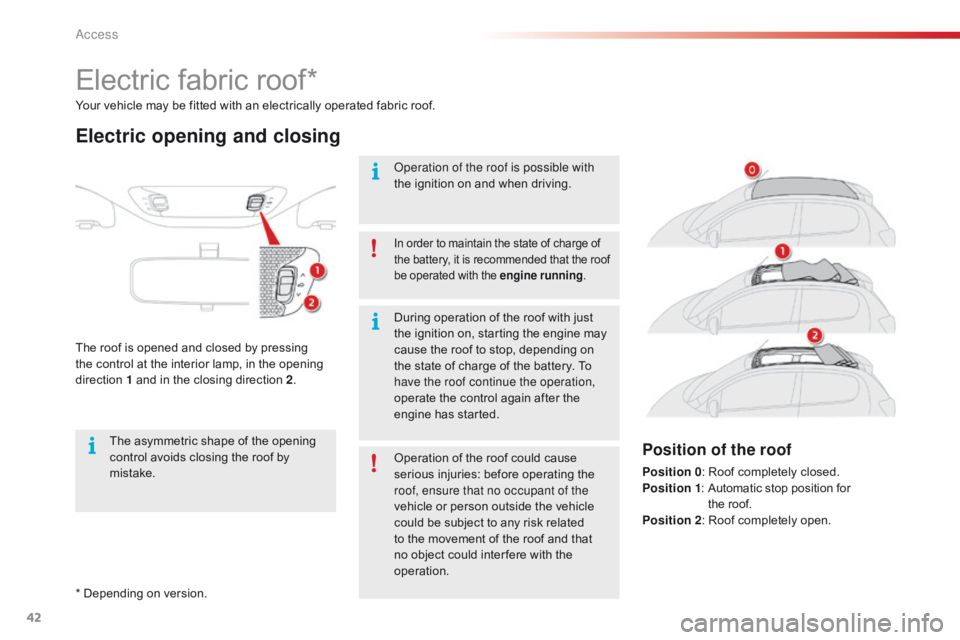
42
C1_en_Chap02_ouvertures_ed01-2016
* Depending on version.
Y our vehicle may be fitted with an electrically operated fabric roof.
Electric fabric ro
of*
Electric opening and closing
The roof is opened and closed by pressing t
he control at the interior lamp, in the opening
d
irection
1
and in the closing direction 2.
In order to maintain the state of charge of t
he battery, it is recommended that the roof b
e operated with the engine running.
Operation of the roof is possible with
the
ignition on and when driving.
Operation
of the roof could cause
s
erious injuries: before operating the
r
oof, ensure that no occupant of the
vehicle
or person outside the vehicle
c
ould be subject to any risk related
t
o the movement of the roof and that
n
o object could inter fere with the
ope
ration.
During
operation of the roof with just
t
he ignition on, starting the engine may
c
ause the roof to stop, depending on
t
he state of charge of the battery. To
h
ave the roof continue the operation,
operate
the control again after the
e
ngine has started.
The
asymmetric
shape
of
the
opening
c
ontrol
avoids
closing
the
roof
by
m
istake.
Position of the roof
Position 0 : Roof completely closed.
Position 1 :
A utomatic stop position for
t
he roof.
Position 2 :
Roof completely open.
Access
Page 72 of 269
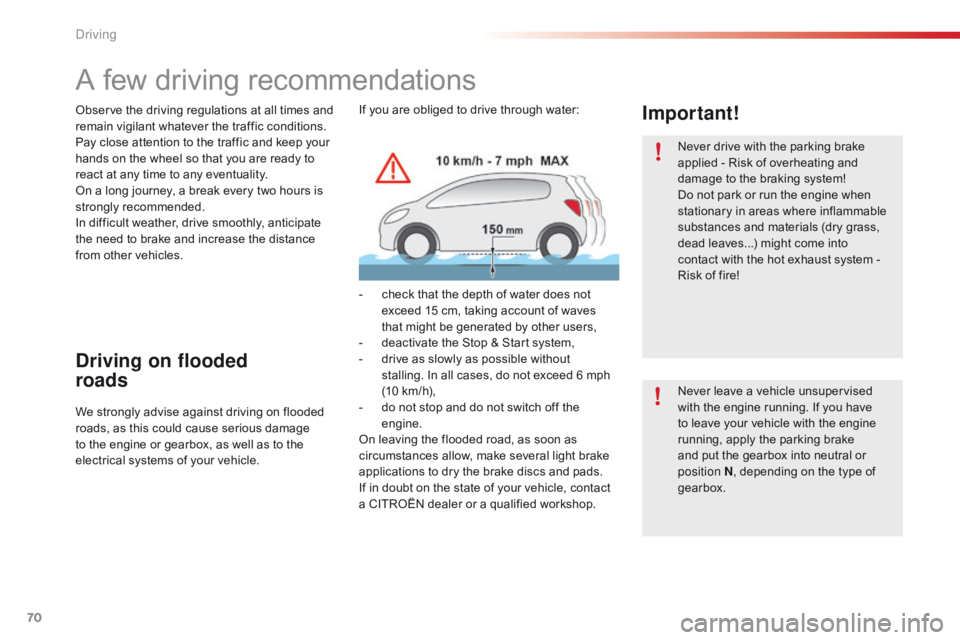
70
C1_en_Chap04_conduite_ed01-2016
A few driving recommendations
Observe the driving regulations at all times and remain vigilant whatever the traffic conditions.
Pay
close attention to the traffic and keep your
h
ands on the wheel so that you are ready to
r
eact at any time to any eventuality.
On
a long journey, a break every two hours is
s
trongly
re
commended.
In
difficult weather, drive smoothly, anticipate
t
he need to brake and increase the distance
f
rom other vehicles. Never
drive with the parking brake
a
pplied - Risk of overheating and
d
amage to the braking system!
Do
not park or run the engine when
s
tationary in areas where inflammable
s
ubstances and materials (dry grass,
d
ead leaves...) might come into
c
ontact with the hot exhaust system -
R
isk of fire!
Never
leave a vehicle unsupervised
w
ith the engine running. If you have
t
o leave your vehicle with the engine
r
unning, apply the parking brake
a
nd put the gearbox into neutral or
p
osition
N,
depending on the type of
g
earbox.
Driving on flooded
roads
We strongly advise against driving on flooded roads, as this could cause serious damage
t
o the engine or gearbox, as well as to the
e
lectrical systems of your vehicle.
Important!If you are obliged to drive through water:
-
c
heck that the depth of water does not
e
xceed 15 cm, taking account of waves
t
hat might be generated by other users,
-
d
eactivate the Stop & Start system,
-
d
rive as slowly as possible without
s
talling. In all cases, do not exceed 6 mph
(
10 km/h),
-
d
o not stop and do not switch off the
e
ngine.
On
leaving the flooded road, as soon as
c
ircumstances allow, make several light brake
a
pplications to dry the brake discs and pads.
If
in doubt on the state of your vehicle, contact
a
CITROËN dealer or a qualified workshop.
Driving
Page 73 of 269
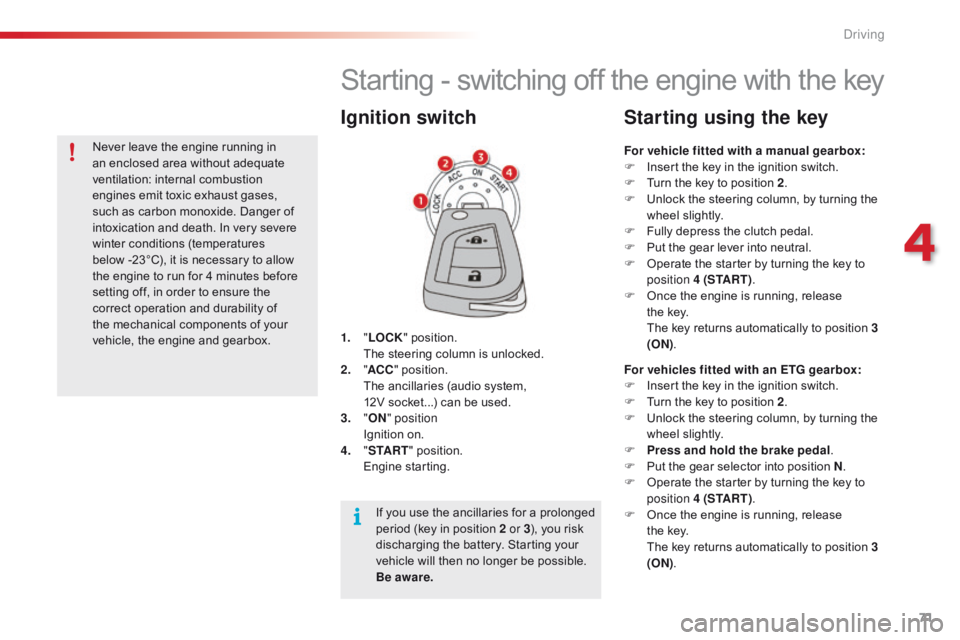
71
C1_en_Chap04_conduite_ed01-2016
Starting - switching off the engine with the key
1. "LOCK " position. T
he steering column is unlocked.
2.
" AC
C"
position.
T
he ancillaries (audio system,
1
2V socket...) can be used.
3.
"ON " position
I
gnition on.
4.
" S
TA R T"
position.
E
ngine
s
tarting.
Ignition switch
For vehicle fitted with a manual gearbox:
F I nsert the key in the ignition switch.
F
T
urn the key to position 2.
F
U
nlock the steering column, by turning the
w
heel slightly.
F
F
ully depress the clutch pedal.
F
P
ut the gear lever into neutral.
F
O
perate the starter by turning the key to
p
osition 4 (S TA R T ) .
F
O
nce the engine is running, release
t
he key.
T
he key returns automatically to position 3
(ON) .
Starting using the key
For vehicles fitted with an ETG gearbox:
F
I nsert the key in the ignition switch.
F
T
urn the key to position 2.
F
U
nlock the steering column, by turning the
w
heel slightly.
F
P
ress and hold the brake pedal .
F
P
ut the gear selector into position N.
F
O
perate the starter by turning the key to
p
osition 4 (S TA R T ) .
F
O
nce the engine is running, release
t
he key.
T
he key returns automatically to position 3
(ON) .
If
you
use
the
ancillaries
for
a
prolonged
p
eriod
(key
in
position
2 or 3 ),
you
risk
d
ischarging
the
battery.
Starting
your
v
ehicle
will
then
no
longer
be
possible.
B
e aware.
Never
leave
the
engine
running
in
a
n
enclosed
area
without
adequate
v
entilation:
in
ternal
c
ombustion
e
ngines
emit
toxic
exhaust
gases,
s
uch
as
carbon
monoxide.
Danger
of
i
ntoxication
and
death.
In
very
severe
w
inter
conditions
(temperatures
b
elow -23°C),
it
is
necessary
to
allow
t
he
engine
to
run
for
4
minutes
before
s
etting
off,
in
order
to
ensure
the
c
orrect
operation
and
durability
of
t
he
mechanical
components
of
your
v
ehicle,
the
engine
and
gearbox.
4
Driving
Page 74 of 269
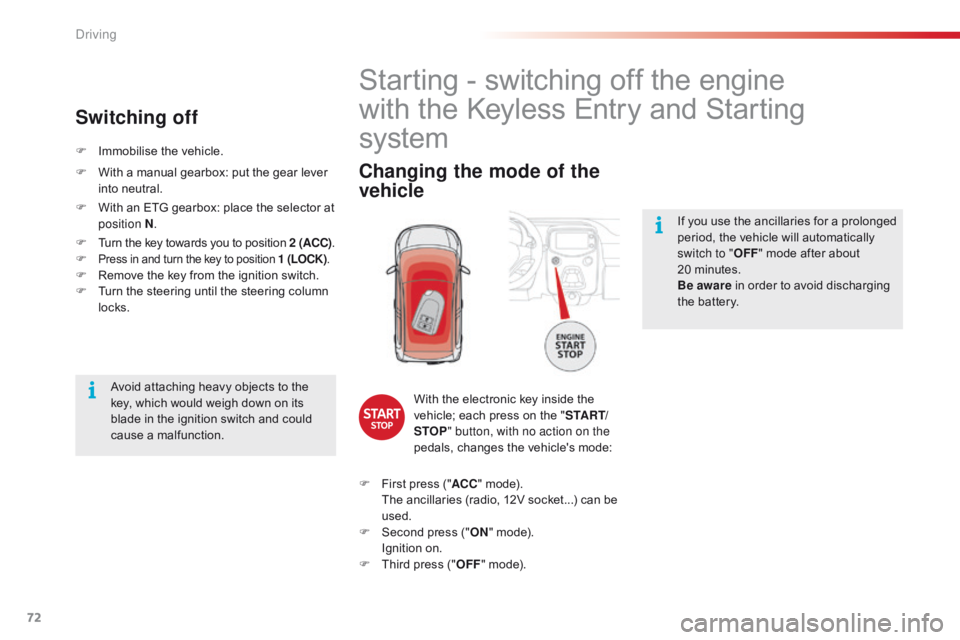
72
C1_en_Chap04_conduite_ed01-2016
If you use the ancillaries for a prolonged period, the vehicle will automatically
s
witch to " OFF"
mode after about
20
m
inutes.
Be aware
in order to avoid discharging
t
he battery.
Starting - switching off the engine
w ith the Keyless Entry and Starting
system
Changing the mode of the
vehicle
With the electronic key inside the v
ehicle; each press on the "S TA R T/
STOP " button, with no action on the
pedals,
changes the vehicle's mode:
F
F
irst
press ("ACC "
mode).
T
he
ancillaries (radio, 12V socket...) can be
u
sed.
F
S
econd press ("ON "
mode).
I
gnition on.
F
T
hird
press ("OFF "
mode).
Avoid
attaching
heavy
objects
to
the
k
ey,
which
would
weigh
down
on
its
b
lade
in
the
ignition
switch
and
could
c
ause
a
malfunction.
F
I
mmobilise
the
vehicle.
Switching off
F With
a manual gearbox: put the gear lever i
nto neutral.
F
W
ith an ETG gearbox: place the selector at
p
osition N .
F
T
urn the key towards you to position 2 (ACC).
F
Press in and turn the key to position 1 (LOCK) .F Remove the key from the ignition switch.
F T urn the steering until the steering column
l
ocks.
Driving